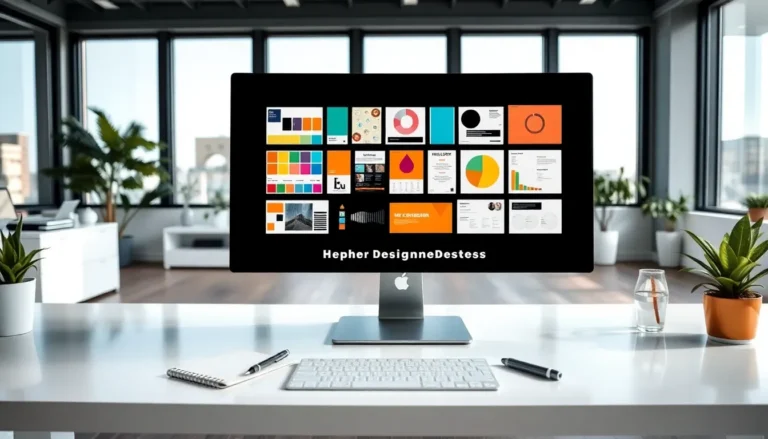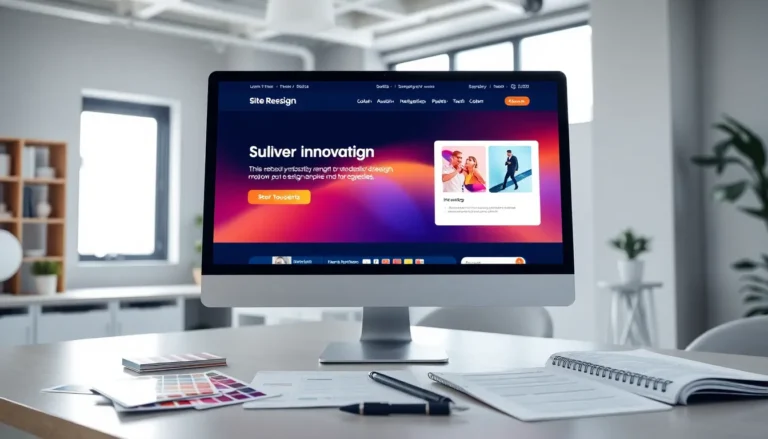Table of Contents
ToggleDesign concepts are the unsung heroes of creativity. They breathe life into ideas, enabling everything from breathtaking architecture to user-friendly apps. But what are design concepts, really? Are they just fancy terms dreamt up by designers sipping overpriced lattes in hipster cafés? Not quite. In this text, we aim to demystify design concepts, explore their importance, jump into different types, and show you how to develop them effectively. Let’s embark on this journey, where creativity meets structure, and perhaps, just maybe, we can have a little fun along the way.
Understanding Design Concepts

Design concepts serve as foundational ideas that guide the creation process. They represent the abstract ideas that evolve into tangible designs, whether it’s for graphic design, interior spaces, or products. Imagine walking into an art gallery: each piece reflects a concept intended to provoke thought or evoke emotion. Just like artists, designers harness these concepts to streamline decisions and inspire innovation.
A design concept can revolve around a theme, idea, or a particular style, helping designers establish clarity in their work. For instance, a minimalist concept focuses on simplicity and functionality, while a surrealist concept explores the bizarre and dream-like qualities of reality. Each of these approaches sets the stage for how a design unfolds, presenting a lens through which to interpret the subject matter.
The Importance of Design Concepts
Why are design concepts so vital? They act as a roadmap that guides designers from the initial brainstorming phase to the final execution. Without a clear concept, projects can easily drift off course, like a ship without a captain.
Besides, design concepts can unify disparate design elements. They help convey a cohesive message, ensuring that every aspect aligns with the intended purpose, whether it’s aesthetics, functionality, or user engagement. By focusing on concepts, designers can carry out a consistent visual language, enhancing user experience and strengthening brand identity. This is especially crucial in digital design, where visitors appreciate seamless interactions.
Types of Design Concepts
Design concepts can vary widely, depending on the medium and the goals of the project.
Elements of Design Concepts
Elements include components like color, shapes, lines, textures, and space. Each element plays a unique role, color evokes emotion, shapes contribute to structure, lines can guide the viewer’s eye, textures add depth, and space offers breathing room. Considering these elements can help refine a design concept and enhance its overall effectiveness.
Principles of Design Concepts
Principles refer to the rules that dictate how design elements work together. These principles include balance, contrast, emphasis, movement, pattern, rhythm, and unity. For example, balance ensures a harmonious composition, while contrast can create visual interest and focus. By mastering these principles, designers can communicate their concepts more effectively and create engaging experiences.
How to Develop Design Concepts
Developing a robust design concept requires significant thought and experimentation. Designers often start by researching and gathering inspiration. Sketching ideas, creating mood boards, or compiling reference materials can help visualize the direction of a concept. Once ideas are shaped, it becomes crucial to select the defining elements and principles that will guide the final product.
Feedback cycles can also enhance the evolution of a design concept. Engaging with peers or stakeholders can provide fresh perspectives, refine ideas, and address potential pitfalls. Prototypes can then be created to test concepts in their real-world applications, allowing adjustments to be made before final execution.
Common Challenges in Design Concept Development
Designing within a concept framework can be tricky. One significant challenge is the tendency to overcomplicate ideas. When designers become enamored with their concepts, they may lose sight of simplicity and functionality, leading to overwhelming designs.
Another hurdle is ensuring alignment between the design concept and user needs. Sometimes, a great idea doesn’t translate into a satisfying user experience. Running user testing and gathering feedback can help bridge this gap, ensuring designs resonate with their intended audience. Finally, working with limited resources, time, budget, or technology, can stifle creativity. But, constraints can also spark innovation, prompting designers to think outside the box.
Case Studies of Successful Design Concepts
Examining real-world examples can illuminate the power of strong design concepts.
For instance, Apple’s design philosophy revolves around simplicity and intuitiveness. Their clean lines and minimalist aesthetic reflect a concept that emphasizes ease of use and elegant design. This commitment to a cohesive concept has contributed to their brand’s strength and recognition.
In another sphere, IKEA’s modular furniture designs are based on functional living. Their concept encapsulates affordability blended with style, appealing to a broad audience. By focusing on user needs and spatial constraints, IKEA has created spaces that encourage creativity in compact living environments.







